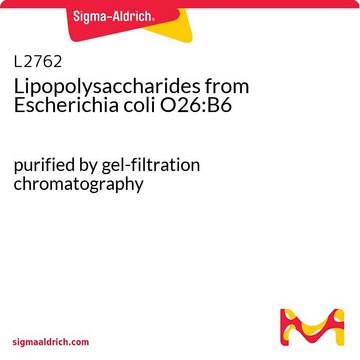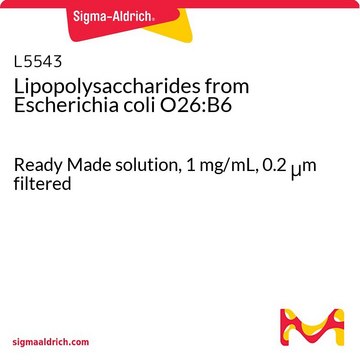L2755
Lipopolysaccharide aus Escherichia coli O128:B12
purified by phenol extraction
Synonym(e):
LPS
Anmeldenzur Ansicht organisationsspezifischer und vertraglich vereinbarter Preise
Alle Fotos(2)
About This Item
Empfohlene Produkte
Biologische Quelle
Escherichia coli (O128:B12)
Qualitätsniveau
Form
lyophilized powder
Aufgereinigt durch
phenol extraction
Verunreinigungen
<3% Protein (Lowry)
Farbe
white to yellow cast
Löslichkeit
water: soluble
Versandbedingung
ambient
Lagertemp.
2-8°C
Suchen Sie nach ähnlichen Produkten? Aufrufen Leitfaden zum Produktvergleich
Allgemeine Beschreibung
This product is phenol extracted from E. coli serotype O128:B12. The source strain is CDC 2440-69.
Anwendung
Lipopolysaccharides (LPSs) are characteristic components of the cell wall of Gram-negative bacteria. LPS and its lipid A moiety stimulate cells of the innate immune system by the Toll-like receptor 4 (TLR4), a member of the Toll-like receptor protein family, which recognizes common pathogen-associated molecular-patterns (PAMPs).
Biochem./physiol. Wirkung
Lipopolysaccharides (LPS) are localized in the outer layer of the membrane and are, in noncapsulated strains, exposed on the cell surface. They contribute to the integrity of the outer membrane, and protect the cell against the action of bile salts and lipophilic antibiotics.
Angaben zur Herstellung
The product is soluble in water (5 mg/ml) or cell culture medium (1 mg/ml) yielding a hazy, faint yellow solution. A more concentrated, though still hazy, solution (20 mg/ml) has been achieved in aqueous saline after vortexing and warming to 70-80 oC. Lipopolysaccharides are molecules that form micelles in every solvent. Hazy solutions are observed in water and phosphate buffered saline. Organic solvents do not give clearer solutions. Methanol yields a turbid suspension with floaters, while water yields a homogeneously hazy solution.
Sonstige Hinweise
To gain a comprehensive understanding of our extensive range of Lipopolysaccharides for your research, we encourage you to visit our Carbohydrates Category page.
Ähnliches Produkt
Produkt-Nr.
Beschreibung
Preisangaben
Signalwort
Danger
H-Sätze
Gefahreneinstufungen
Acute Tox. 2 Oral
Lagerklassenschlüssel
6.1A - Combustible acute toxic Cat. 1 and 2 / very toxic hazardous materials
WGK
WGK 3
Flammpunkt (°F)
Not applicable
Flammpunkt (°C)
Not applicable
Hier finden Sie alle aktuellen Versionen:
Besitzen Sie dieses Produkt bereits?
In der Dokumentenbibliothek finden Sie die Dokumentation zu den Produkten, die Sie kürzlich erworben haben.
Kunden haben sich ebenfalls angesehen
Stephen B Pruett et al.
BMC immunology, 10, 49-49 (2009-09-22)
Previous reports indicate that ethanol, in a binge drinking model in mice, inhibits the production of pro-inflammatory cytokines in vivo. However, the inhibition of signaling through TLR4 has not been investigated in this experimental model in vivo. Considering evidence that
Elena A Khatuntseva et al.
Beilstein journal of organic chemistry, 8, 763-775 (2012-09-28)
Two new triterpenoid saponins 1 and 2 were isolated from the methanol extract of the roots of Acanthophyllum gypsophiloides Regel. These saponins have quillaic acid or gypsogenin moieties as an aglycon, and both bear similar sets of two oligosaccharide chains
Ester Zito et al.
Molecular cell, 40(5), 787-797 (2010-12-15)
Endoplasmic reticulum (ER) oxidation 1 (ERO1) transfers disulfides to protein disulfide isomerase (PDI) and is essential for oxidative protein folding in simple eukaryotes such as yeast and worms. Surprisingly, ERO1-deficient mammalian cells exhibit only a modest delay in disulfide bond
Elsa Youngsteadt et al.
PloS one, 10(11), e0142031-e0142031 (2015-11-05)
Given the role of infectious disease in global pollinator decline, there is a need to understand factors that shape pathogen susceptibility and transmission in bees. Here we ask how urbanization affects the immune response and pathogen load of feral and
Yijing Su et al.
Journal of applied toxicology : JAT, 34(12), 1436-1442 (2014-10-22)
Isoniazide (INH) is a classic antituberculosis drug associated with clinical idiosyncratic drug-induced liver injury. It has been hypothesized that the interaction between a drug and modest inflammation results in a decreased threshold for drug toxicity. In this study, we tested
Unser Team von Wissenschaftlern verfügt über Erfahrung in allen Forschungsbereichen einschließlich Life Science, Materialwissenschaften, chemischer Synthese, Chromatographie, Analytik und vielen mehr..
Setzen Sie sich mit dem technischen Dienst in Verbindung.




